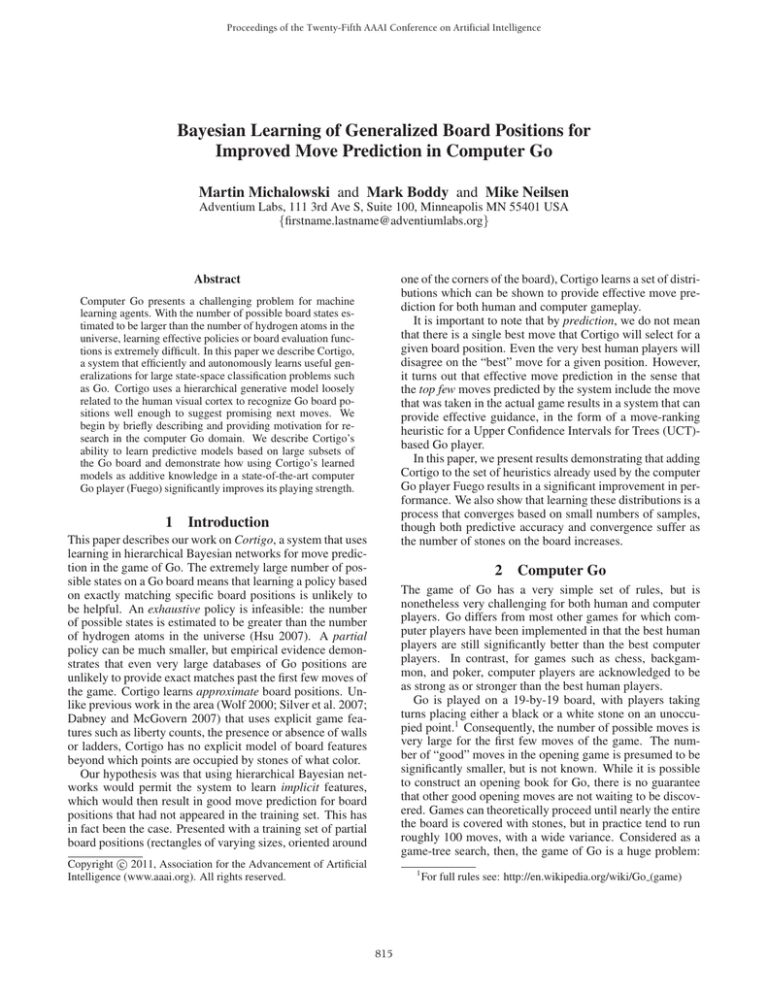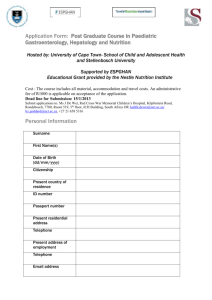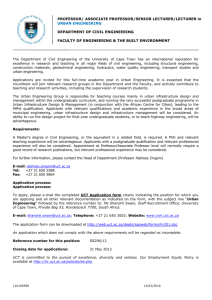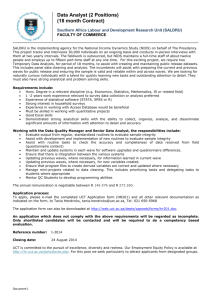
Proceedings of the Twenty-Fifth AAAI Conference on Artificial Intelligence
Bayesian Learning of Generalized Board Positions for
Improved Move Prediction in Computer Go
Martin Michalowski and Mark Boddy and Mike Neilsen
Adventium Labs, 111 3rd Ave S, Suite 100, Minneapolis MN 55401 USA
{firstname.lastname@adventiumlabs.org}
one of the corners of the board), Cortigo learns a set of distributions which can be shown to provide effective move prediction for both human and computer gameplay.
It is important to note that by prediction, we do not mean
that there is a single best move that Cortigo will select for a
given board position. Even the very best human players will
disagree on the “best” move for a given position. However,
it turns out that effective move prediction in the sense that
the top few moves predicted by the system include the move
that was taken in the actual game results in a system that can
provide effective guidance, in the form of a move-ranking
heuristic for a Upper Confidence Intervals for Trees (UCT)based Go player.
In this paper, we present results demonstrating that adding
Cortigo to the set of heuristics already used by the computer
Go player Fuego results in a significant improvement in performance. We also show that learning these distributions is a
process that converges based on small numbers of samples,
though both predictive accuracy and convergence suffer as
the number of stones on the board increases.
Abstract
Computer Go presents a challenging problem for machine
learning agents. With the number of possible board states estimated to be larger than the number of hydrogen atoms in the
universe, learning effective policies or board evaluation functions is extremely difficult. In this paper we describe Cortigo,
a system that efficiently and autonomously learns useful generalizations for large state-space classification problems such
as Go. Cortigo uses a hierarchical generative model loosely
related to the human visual cortex to recognize Go board positions well enough to suggest promising next moves. We
begin by briefly describing and providing motivation for research in the computer Go domain. We describe Cortigo’s
ability to learn predictive models based on large subsets of
the Go board and demonstrate how using Cortigo’s learned
models as additive knowledge in a state-of-the-art computer
Go player (Fuego) significantly improves its playing strength.
1
Introduction
This paper describes our work on Cortigo, a system that uses
learning in hierarchical Bayesian networks for move prediction in the game of Go. The extremely large number of possible states on a Go board means that learning a policy based
on exactly matching specific board positions is unlikely to
be helpful. An exhaustive policy is infeasible: the number
of possible states is estimated to be greater than the number
of hydrogen atoms in the universe (Hsu 2007). A partial
policy can be much smaller, but empirical evidence demonstrates that even very large databases of Go positions are
unlikely to provide exact matches past the first few moves of
the game. Cortigo learns approximate board positions. Unlike previous work in the area (Wolf 2000; Silver et al. 2007;
Dabney and McGovern 2007) that uses explicit game features such as liberty counts, the presence or absence of walls
or ladders, Cortigo has no explicit model of board features
beyond which points are occupied by stones of what color.
Our hypothesis was that using hierarchical Bayesian networks would permit the system to learn implicit features,
which would then result in good move prediction for board
positions that had not appeared in the training set. This has
in fact been the case. Presented with a training set of partial
board positions (rectangles of varying sizes, oriented around
2
Computer Go
The game of Go has a very simple set of rules, but is
nonetheless very challenging for both human and computer
players. Go differs from most other games for which computer players have been implemented in that the best human
players are still significantly better than the best computer
players. In contrast, for games such as chess, backgammon, and poker, computer players are acknowledged to be
as strong as or stronger than the best human players.
Go is played on a 19-by-19 board, with players taking
turns placing either a black or a white stone on an unoccupied point.1 Consequently, the number of possible moves is
very large for the first few moves of the game. The number of “good” moves in the opening game is presumed to be
significantly smaller, but is not known. While it is possible
to construct an opening book for Go, there is no guarantee
that other good opening moves are not waiting to be discovered. Games can theoretically proceed until nearly the entire
the board is covered with stones, but in practice tend to run
roughly 100 moves, with a wide variance. Considered as a
game-tree search, then, the game of Go is a huge problem:
c 2011, Association for the Advancement of Artificial
Copyright Intelligence (www.aaai.org). All rights reserved.
1
815
For full rules see: http://en.wikipedia.org/wiki/Go (game)
the tree depth is on the order of 100 and the branching factor is on the order of the size of the board for at least the
first few moves. The number of states is immense and there
are no obvious means to factor or partition them, beyond the
obvious rotational and reflective symmetries.
Recent approaches to computer Go have either treated
it as a stochastic search problem, using a sampling-based
heuristic search algorithm known as Upper Confidence Intervals for Trees (UCT), or as a learning problem, or as
some combination of the two (Bouzy and Cazenave 2001).
Learning for computer Go has included attempting to learn
policies via reinforcement learning (Silver et al. 2007), or
learning classifiers for board positions, such that each board
comes with a suggested next move (Stern, Herbrich, and
Graepel 2006). At this point, the strongest players are all
variants on or refinements of UCT. One of the strengths of
the UCT approach, and one of the reasons for the wide variety of competitive UCT-based Computer Go players (e.g.,
Fuego, Crazy Stone, MoGo, Zen, etc.) is that the UCT algorithm presents several opportunities for heuristic approaches
and enhancements, including but not limited to the selection
of nodes for expansion and biasing the Monte Carlo search
used to evaluate those nodes.
3
Figure 1: Multilayer pyramidal Bayes net, from (Dean 2006)
of an exact match on board position in even a large database
are very low.
Consequently, we treat this as a generalization problem:
given a limited set of training samples consisting of a quadrant board position and the next move in that quadrant, learn
a function such that the move(s) suggested based on a position in a game not previously seen will include the move
that was actually taken in that game. This problem is made
more difficult by the fact that it is not obvious how to characterize two board positions as being “close” to one another.
Removing a single stone from the board, or moving a stone
on the board a single point in any direction, can have drastic effects on the strength of the resulting positions for each
player.
As mentioned earlier, previous work on computer Go
players has sometimes relied on defining specific features
thought to be relevant to this classification problem. In
contrast, Cortigo starts with no assumptions about specific
relevant features above the level of individual points on
the board. Cortigo deals with the problem of approximate
matches on the board position and multiple possible moves
for any given position by learning distributions, encoded as
a set of weights within a hierarchical Bayesian network. As
shown in Figure 1, this network has a very specific structure, known as a Pyramidal Bayes Net (PBN), and is part
of a more general approach known as Hierarchical Generative Models (Dean 2005; 2006). Intended to be loosely
analogous to the visual cortex, these structures have been
shown by Dean to provide some of the same benefits in terms
of preserving recognition of objects and structures through
translation and scaling changes, and in the presence of noisy
or missing data. We specifically chose PBNs for their use of
discrete-valued (non-binary) nodes and their explicit hierarchy of levels to aid in the required generalization.
In application to recognition (i.e., classification) problems
involving visual images, at each but the lowest level the
nodes in a PBN take as input the output of the nodes below them in a fixed topology. The “visual field” for nodes
at a given level overlap: they share some input nodes in the
next level down, thus increasing the degree to which larger
features can be captured in correlations between inputs to
neighboring nodes at the higher level. Due to the nature
Cortigo
Cortigo provides a ranking on possible next moves for a
given board position. Cortigo does this using move prediction: mapping from a given board position to a prediction of the next move that would be made by an expert
Go player. The moves are ordered in decreasing likelihood
that that move would be taken given the current board position, given the distributions that have been learned in a
previously-trained hierarchical Bayes net, described below.
In many ways, this is an easy domain for this kind of classification problem. The description of the current board position is simple in structure and small in size, consisting only
of the current state of each point on the board. For a board
position appearing in any given game, the output of the classifier is unambiguous: the next move taken. Finally, this is
a domain where very extensive training and testing data is
available. Go has been played for hundreds of years in very
close to its current form, and many of those games have been
recorded in detail.
If the problem were that straightforward, the easy solution would be to buy a large game database,2 and match the
current board position to those appearing in saved games,
resulting in a selection of suggested moves based on a long
history of expert play. However, the size of the state space
makes finding a match for the current position very unlikely,
even if we limit ourselves to considering quadrants of the
board, looking for matches under all of the obvious rotational and reflective symmetries. One might object that what
matters is not the absolute size of the state space, but the
number of states that are likely to be visited in the course
of competent play. This does reduce the state space, but not
enough: fewer than a dozen moves into the game, the odds
2
For example, see http://bigo.baduk.org/index.html
816
of probabilistic inference, nodes corresponding to different
parts of the visual field are correlated by virtue of having
common children at the next level up, thus biasing the model
towards more likely combinations of features.
Mapping from Go board positions to suggested moves fits
well with this approach. The “image” is small, with both
a limited number of pixels and a very limited pixel depth
(3 possible values being white/black stone or empty space).
Learning an approximate mapping from board positions to
likely next moves is crucial, due to the huge number of possible board positions after the first few moves, and to there
being multiple possible next moves for any given position.
Finally, there are clearly large-scale features of strategic significance in the game, even if it is difficult to systematically
characterize or prioritize them.
4
either 81 or 95 values, corresponding to the number of possible moves in the region. Choices for topology and domain
size are empirical, optimizing over the configurations considered.
Sample generation
Both training and test sets were generated from the KGS
data described above. Each sample consists of a partial
board position (the state of the points contained in the 9x9 or
5x19 subset of the board), plus the next move in the game. If
that move is in the region in question, the sample is retained.
Otherwise (i.e., if the next move in the game was in some
other part of the board), the sample is discarded.
Training
Each of the models is trained using expectation maximization over the set of training samples, each consisting of a
board position (fixing the values of the bottom-layer nodes)
and a next move (fixing the value of the top-level node). The
overall PBN is subdivided into subnets each corresponding
to a single node at each level above the lowest and the nodes
in that node’s “visual field” at the next level down. Expectation maximization is used to estimate the parameters of each
subnet. At the first level, training samples correspond to the
inputs (board positions) and at all other levels training data
is acquired by sampling a posterior belief function over the
observable nodes for that subnet. We trained models over
varying sizes of training sets, including 30, 700, 5000, and
40000 samples. Training times were prohibitive for significantly more than 40000 samples.
Experimentation
Ultimately, the relevant metric for evaluating progress in
this area is improved performance: if our aim is improved
heuristics for UCT computer Go players, how much better
does a given player do with Cortigo than without it? This
question is addressed in Section 5. In this section, we evaluate predictive accuracy: presented with a novel board position, how well does Cortigo rank the move that was actually
taken in the game from which that position is drawn? We
also address convergence: the number of samples required
to converge to a reasonably stable set of distributions.
The data used in these experiments comes from games
stored in the KGS Go Server game database (Görtz and Shubert 2008). These games involve the top expert skill-level
players participating in non-professional games on KGS, in
which either one player is at least 7 dan, or both players are
at least 6 dan.3
The Models
In order to reduce training and evaluation time and to increase the likelihood of finding at least an approximate
match to a given board position, all the models we learned
and subsequently evaluated covered only subsets of the
board. These models came in two forms: 9x9 quadrants
around a single corner of the board, and 5x19 fields along
each side. These shapes are chosen to cover regions that
frequently contain features of interest in Go. The corners
and edges of the board are the main focus of play, especially
early in the game.
The topology of the PBN has a pronounced effect on how
fast the model converges, and on the quality of the resulting
performance. All of the results reported here were obtained
using 4-level PBNs, with either 81 or 95 nodes in the bottom
layer, each with three possible values (white, black, empty).
Nodes in the second and third layers have 3x3 visual fields
in the next level down. These visual fields have a 1-pixel
overlap, such that adjacent nodes at one level share observable nodes at the next level down. Finally, the top-level node
has as observable nodes all the nodes in the third layer. The
domain sizes for second and third-level nodes are 12 and 7,
respectively, and the single top-level node has a domain of
3
Figure 2: Combined model coverage on a 19x19 board.
Evaluation
In our experiments, the models exhibited significantly improved predictive accuracy (and a more strongly positive effect on UCT game play) when we trained models for a fixed
number of stones within the relevant part of the board. Consequently, we trained individual models for stone counts in
the range {0 . . . 20}. Those models are then used to evaluate
board positions with the corresponding number of stones in
that part of the board. We also observed that both predictive
accuracy and convergence are better for positions involving
fewer stones.
Dan grades indicate a player’s skill in the game of Go
817
(a) 9x9 model
(b) 5x19 model
(c) Combined model
Figure 3: Top-k results for models trained on 3-stone positions
erage result. Although each game is of relatively low quality by itself, the statistics over many random games show
a higher evaluation result for better positions. The UCT
algorithm adds focused search to this, using partial statistics at repeatedly visited nodes in the tree to select the most
promising candidates for subsequent playouts (Kocsis and
Szepesvári 2006a). In addition, the top Monte Carlo/UCT
Go programs include small amounts of external knowledge
to focus search on the highest-priority candidates and to bias
Monte Carlo random move selections towards better moves
(Gelly and Silver 2007; Coulom 2007).
Fuego (Enzenberger and Müller 2009) is a Monte
Carlo/UCT Go program that was developed to provide an
effective platform for investigating the integration of machine learning methods. Having a strong program ensures
that methods being tested are being evaluated by their effect
on playing strength that is near state-of-the-art. Currently, at
tournament settings and running on a standard workstation,
Fuego (v. 0.4.1) defeats the classical Go program GnuGo
(v. 3.6 level 10) over 63% of the time on the 19x19 board.
As discussed above, the type of model being learned by
Cortigo is well-suited to incorporation into a UCT Go player
such as Fuego. Providing a ranked set of move choices
fits perfectly with the UCT algorithm’s stochastic choice of
nodes to expand next. Cortigo’s predictive knowledge is incorporated as an additive modification to the UCT formula
(Kocsis and Szepesvari 2006b) used by Fuego, the details of
which are described in (Rosin 2010). Due to Cortigo’s normalized probability distribution it can be used as an additive
term to boost and inhibit moves on the board. As Cortigo
outputs a ranked list of moves for a single quadrant, we apply the model in all four quadrants for a single board position.
To test the impact Cortigo has on Fuego’s performance,
Fuego played GnuGo (v. 3.6 level 10) both with and without Cortigo’s additive knowledge for 500 games. Cortigo’s
current implementation is comparatively slow, introducing
roughly a 3x slowdown in Fuego. To ensure a fair evaluation, we ran Fuego with and without Cortigo both using
10,000 playouts (starting from the root node), with no time
We evaluated move prediction accuracy for both 9x9 and
5x19 models. Specifically, we looked at whether the specific
move taken next in the game from which the given evaluation sample was drawn appears in the top k moves, ranked
according to a posterior distribution over the possible values
of the top-level node in the model, given the current board
position as observed values for the nodes in the lowest level.
We also evaluated the predictive accuracy of combined
models, making use of both 9x9 and 5x19 trained models.
The intuition behind this experiment is that each type of
model has an extent that will encompass different types of
board features. In the case of combined models, the process
by which test samples are generated is modified slightly. For
each quadrant, we combine results from the corresponding
9x9 quadrant, and each of the two 5x19 strips including that
corner. The total area covered is the shaded region of a
19x19 Go board shown in Figure 2.
The results for training and evaluation on board positions
including 3, 5 and 10 stones are shown in Figures 3, 4, and
5, respectively. Each figure plots the predictive accuracy
as a percentage (the y-axis) as it changes over the range {1
. . . 20} of k (the x-axis) for our four different training sample
sizes. The individual models show good predictive accuracy
and convergence for small numbers of stones (so, early in
the game). Combining the two models results in significant
improvements in both predictive accuracy and convergence.
As we discuss in Section 6, these results exhibit a higher
predictive accuracy using a fraction of the training examples
when compared to existing Bayesian-based approaches.
As this is a generalization problem addressed using a hierarchical model, one possibility to investigate is the presence
of “grandma” nodes: specific nodes that have been trained to
recognize particular features. In this evaluation, we found no
obvious correspondence between intermediate node values
and specific configurations of stones, but our investigation
was not extensive enough to be conclusive in this regard.
5
Integration With a Computer Go Player
Monte Carlo approaches for Go evaluate positions by playing many games with randomized moves and taking the av-
818
(a) 9x9 model
(b) 5x19 model
(c) Combined model
Figure 4: Top-k results for models trained on 5-stone positions
(a) 9x9 model
(b) 5x19 model
(c) Combined model
Figure 5: Top-k results for models trained on 10-stone positions
6
limits. This setup ensures each player searched the same
number of lines of play. For the version of Fuego using Cortigo, we provided 9x9 models trained on stone counts S =
{0 . . . 20} and PBNs as described in Section 4. Cortigo’s
influence was thus only in the first 20 moves in any given
quadrant. Note as well that this means that Fuego was not
using the models for which we report the best results, which
are the combined models.
Games won
Games played
Winning Percentage
Fuego + Cortigo
350
500
70.0
Related Work
Applying Bayesian methods, including hierarchical generative models, to feature recognition and image classification
is an active area of research. A wide range of approaches
have been employed for feature detection and extraction, image classification, and either incorporating or inferring annotations for both features and images. All of these are potentially of use in Go, or in other applications involving planning over a two-dimensional field, such as maneuver planning for military operations (Li, Socher, and Fei-Fei 2009;
Du et al. 2009). Research in this area has made significant
progress over the past few years, resulting in new capabilities that we may wish to incorporate into Cortigo. The work
on either inferring or employing annotations seems to be
particularly promising.
Work by David Stern and colleagues (Stern, Herbrich, and
Graepel 2006) also applies Bayesian inference to the problem of move prediction for computer Go players. This approach employs a two-phase learning process. First, local
patterns are extracted from expert games. Each pattern is an
exact arrangement of stones on the board, centered around
an empty location where a move could be made. Each pattern is then augmented with 8 binary features selected by the
authors and Bayesian models are learned and used to select
the largest matched pattern whose empty location represents
Fuego w\o Cortigo
319
500
63.8
Table 1: Fuego winning percentage with and without Cortigo additive knowledge.
Table 1 shows that even with influence only in the opening game, Cortigo improves the playing strength of Fuego
by a statistically significant 6.2%. As future work we will
explore the influence our combined models have on Fuego’s
playing strength. Integrating the combined models into a
UCT-based player is non-trivial as their coverage is nonuniform and the returned move probabilities interact with
the UCT formula in ways requiring further study.
819
References
the next move. The authors use roughly 45,000,000 moves
for training and learn roughly 12,000,000 patterns, presenting a top-k accuracy of 86% for k = 20. Our Cortigo models achieve better predictive accuracy for moves early in the
game, while training on a far smaller number of samples.
Additionally our proposed method has the significant advantage that it operates simply on the raw board configuration
of a Go position, with no need for complex feature engineering. However, it is possible that the more complex features
in Stern’s work will provide better performance with more
stones on the board than Cortigo is capable of. Finally, the
work of Tidwell et al. (Tidwell, Hellman, and McGovern
2011) also considers the problem of expert move prediction,
in their case using spatial probability models called Spatial
Probability Trees (SPTs). We consider this work complementary to ours, as it provides additional additive knowledge
that can be used by the UCT-based Go player.
7
Bouzy, B., and Cazenave, T. 2001. Computer go: an ai oriented
survey. Artificial Intelligence 132:39–103.
Coulom, R. 2007. Computing Elo ratings of move patterns in the
game of Go. In Computer Games Workshop 2007. MICC Technical
Report Series, number 07-06.
Dabney, W., and McGovern, A. 2007. Utile distinctions for relational reinforcement learning. In IJCAI’07, 738–743.
Dean, T. 2005. A computational model of the cerebral cortex. In
Proceedings of AAAI 2005, 938–943.
Dean, T. 2006. Scalable inference in hierarchical generative models. In Proceedings of the Ninth International Symposium on Artificial Intelligence and Mathematics.
Du, L.; Ren, L.; Dunson, D. B.; and Carin, L. 2009. A bayesian
model for simultaneous image clustering, annotation, and object
segmentation. In Neural and Information Processing Systems
(NIPS).
Enzenberger, M., and Müller, M. 2009. Fuego - an open-source
framework for board games and go engine based on monte-carlo
tree search. Technical report, Dept. of Computing Science, University of Alberta.
Gelly, S., and Silver, D. 2007. Combining online and offline knowledge in UCT. In ICML’07.
Görtz, U., and Shubert, W. 2008. Game records in SGF format.
http://www.u-go.net/gamerecords.
Hsu, F.-H. 2007. Cracking go. IEEE Spectrum 10:50–55.
Kocsis, L., and Szepesvári, C. 2006a. Bandit based Monte-Carlo
planning. In Proceedings of the European Conference on Machine
Learning, 282–293.
Kocsis, L., and Szepesvari, C. 2006b. Bandit based monte-carlo
planning. In ECML-06, 282–293.
Li, L.-J.; Socher, R.; and Fei-Fei, L. 2009. Towards total scene understanding:classification, annotation and segmentation in an automatic framework. In Proc. IEEE Computer Vision and Pattern
Recognition (CVPR).
Rosin, C. D. 2010. Multi-armed bandits with episode context. In
Proceedings of the Eleventh International Symposium on Artificial
Intelligence and Mathematics (ISAIM ’10).
Silver, D.; Sutton, R.; ; and Müller, M. 2007. Reinforcement
learning of local shape in the game of go. In IJCAI’07, 1053–1058.
Stern, D.; Herbrich, R.; and Graepel, T. 2006. Bayesian pattern
ranking for move prediction in the game of go. In ICML ’06: Proceedings of the 23rd international conference on Machine learning,
873–880.
Tidwell, Z.; Hellman, S.; and McGovern, A. 2011. Expert move
prediction for computer go using spatial probability trees. Technical Report OU-CS-2011-100, University of Oklahoma.
Wolf, T. 2000. Forward pruning and other heuristic search techniques in tsume go. Information Sciences 1:59–76.
Discussion and Future Work
The work described in this paper clearly indicates a promising avenue for further research. There are several directions
in which this work could be extended.
Using the current training code implemented in Matlab,
training runs of 40,000 samples required up to several days
to complete. Speeding up training times would allow us to
use larger training sets, which the shape of the graphs presented in this paper suggest would have a positive effect on
predictive accuracy, though the size of that effect is difficult
to estimate.
The drop-off in predictive accuracy with more stones on
the board also raises a more fundamental question: is there a
point at which this approach will simply cease to be useful,
as the number of stones on the board increases? Intuitively,
the answer would seem to be yes. The more stones are on
the board, the more likely they are to be connected (where
“connected” on a Go board has a complex meaning, depending on context). This makes it more likely that details of the
board position significantly separated from one another and
from any potential move should have a large effect on move
ranking. It is possible that trying alternative topologies in the
PBN would mitigate this effect, for example by facilitating
the learning of more complex features of the board position.
Finally, modern UCT Go players incorporate multiple
heuristics at different points in the algorithm, all tunable by
adjusting different parameters. It would be very interesting
to see what would result from a systematic exploration of
this space, specifically including the use of Cortigo’s move
rankings. What we have demonstrated here is the improvement in play resulting from adding Cortigo’s models while
changing no other parameters affecting Fuego’s search. That
leaves a very large space of alternative configurations, some
of which might result in still better performance.
8
Acknowledgements
This work was supported in part by the DARPA GALE
project, Contract No. HR0011-08-C-0110. The authors
would also like to thank three anonymous reviewers for a
thorough reading and comments both extensive and helpful.
820








